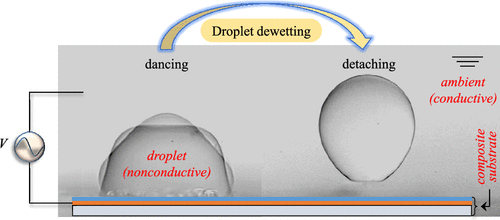Our official English website, www.x-mol.net, welcomes your feedback! (Note: you will need to create a separate account there.)
Manipulation of a Nonconductive Droplet in an Aqueous Fluid with AC Electric Fields: Droplet Dewetting, Oscillation, and Detachment
Langmuir ( IF 3.9 ) Pub Date : 2021-09-14 , DOI: 10.1021/acs.langmuir.1c01934 Qinggong Wang 1 , Long Li 1 , Junping Gu 1 , Ce Zhang 1 , Junfu Lyu 2 , Wei Yao 1
Langmuir ( IF 3.9 ) Pub Date : 2021-09-14 , DOI: 10.1021/acs.langmuir.1c01934 Qinggong Wang 1 , Long Li 1 , Junping Gu 1 , Ce Zhang 1 , Junfu Lyu 2 , Wei Yao 1
Affiliation

|
Electrowetting (EW) is an effective method for droplet manipulation in microfluidics. In traditional EW, a conductive droplet is actuated, which spreads on a solid substrate. Recently, we considered an opposite phenomenon of droplet actuation in EW: inducing nonconductive droplet dewetting and detaching from the substrate. An oil/water system is used in which the oil droplet (nonconductive) is actuated on a flat substrate in surrounding water (conductive) by EW. In this work, alternating current (AC) electric fields are applied to EW, and the transient dynamics of droplet dewetting, oscillation, and detachment with the AC signals are investigated. The droplet is not in contact with electrodes, and it dances freely on the substrate. Experiments are performed in a wide range of voltages and AC frequencies. To demonstrate the droplet dynamics, we divide the full process of droplet manipulation into three distinguishable periods, that is, an initiating period, a steady oscillation period, and a detaching condition. Transient droplet dewetting is considered in the initiating period, and we obtain the distribution of the contact line friction factor. In steady oscillation, the oscillation resonance is verified from the oscillating amplitude of the contact line. Different periodical features are found for the droplet dancing at the resonance frequencies and departure from resonance. The droplet is detached at high voltages, and we provide a map for the detachable and nondetachable zones. The voltage is the dominant factor determining the droplet detachment; however, the AC frequency has notable influences on the critical voltage. The detachment is promoted when the AC frequency is within the region of the oscillation resonance (e.g., 20 < f < 75 Hz). In this region, the detaching process is not monotonic but instead, the droplet rebounds by several times before it is completely detached.
中文翻译:

使用交流电场操纵水性流体中的非导电液滴:液滴去湿、振荡和分离
电润湿 (EW) 是一种有效的微流体液滴操作方法。在传统的电子战中,导电液滴被驱动,在固体基板上扩散。最近,我们考虑了电子战中液滴驱动的一种相反现象:诱导非导电液滴去湿并从基板上分离。使用油/水系统,其中油滴(不导电)通过电子战在周围水(导电)中的平坦基底上致动。在这项工作中,交流 (AC) 电场应用于 EW,并研究了交流信号下液滴去湿、振荡和脱离的瞬态动力学。液滴不与电极接触,而是在基板上自由舞动。实验是在很宽的电压和交流频率范围内进行的。为了演示液滴动力学,我们将液滴操纵的整个过程分为三个可区分的时期,即起始期、稳定振荡期和脱离条件。在初始阶段考虑了瞬态液滴去湿,我们得到了接触线摩擦系数的分布。在稳态振荡中,振荡共振是通过接触线的振荡幅度来验证的。对于在共振频率下跳舞和偏离共振的液滴,发现了不同的周期性特征。液滴在高压下分离,我们提供了可分离和不可分离区域的图。电压是决定液滴脱离的主要因素;然而,交流频率对临界电压有显着影响。例如,20 < f < 75 Hz)。在这个区域,分离过程不是单调的,而是液滴在完全分离之前反弹了几次。
更新日期:2021-10-19
中文翻译:

使用交流电场操纵水性流体中的非导电液滴:液滴去湿、振荡和分离
电润湿 (EW) 是一种有效的微流体液滴操作方法。在传统的电子战中,导电液滴被驱动,在固体基板上扩散。最近,我们考虑了电子战中液滴驱动的一种相反现象:诱导非导电液滴去湿并从基板上分离。使用油/水系统,其中油滴(不导电)通过电子战在周围水(导电)中的平坦基底上致动。在这项工作中,交流 (AC) 电场应用于 EW,并研究了交流信号下液滴去湿、振荡和脱离的瞬态动力学。液滴不与电极接触,而是在基板上自由舞动。实验是在很宽的电压和交流频率范围内进行的。为了演示液滴动力学,我们将液滴操纵的整个过程分为三个可区分的时期,即起始期、稳定振荡期和脱离条件。在初始阶段考虑了瞬态液滴去湿,我们得到了接触线摩擦系数的分布。在稳态振荡中,振荡共振是通过接触线的振荡幅度来验证的。对于在共振频率下跳舞和偏离共振的液滴,发现了不同的周期性特征。液滴在高压下分离,我们提供了可分离和不可分离区域的图。电压是决定液滴脱离的主要因素;然而,交流频率对临界电压有显着影响。例如,20 < f < 75 Hz)。在这个区域,分离过程不是单调的,而是液滴在完全分离之前反弹了几次。



























 京公网安备 11010802027423号
京公网安备 11010802027423号